
w
flick more than an inch deep in the bank. The out
fide is very woolly, attaching it to ftraws and other
fubftances in its way. In drying it becomes toughifli
and leathery, and lefs vivid in colour.
T A B. XIV.
AGARICUS CLYFEOLARIUS Pf'itb. V. 3. 379.
T H I S occurs frequently in woods and fir plantations
in damp weather. It certainly includes the A. mekagris
of Withering. The ring is occafionally wanting,
nor can I call it permanent.
Many Agarics have, like this, a loofe pith, but fo
tender it often Aides along with the blade of the inifrument
ufed to divide the ftalk.
T A B . XV.
H Y D N U M DAVIESII.
A RARE fpecies, hitherto I believe difcovered only
by the Rev. Mr. Hugh Davies, on a decaying apple-tree
in Llyfdulas garden Anglefea, 1790, f rom whom 1 have
been favoured with excellent and well preferved fpecimens.
It much refembles Boletus verficolor in colour
and texture, and by the upper furface might be miftaken
for that fungus.
t a b . XVI.
PEZIZA MARGINATA Relh. Fl. Cant. Suppl. 2. 29.
MTH. V. 3.440.
T H E Rev. Mr. Relhan communicated the fpecimens
from which the figure was drawn. It may be feen alfo
in F/o. Dan. t. 779. f . i-
T A B . XVII.
PEZIZA BICOLOR Bulliard t.
COMMON on fallen branches of oak and other trees,
often covering them copioully on every fide. It is
either feffile or ftipitate. This differs f rom P. nivea of
Dickfon and Withering in its orange-coloured centre,
and in having occafionally a ftalk; nor do I know that
any Britifli writer has noticed it.